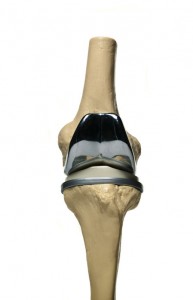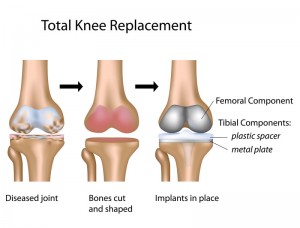Orthopedic surgeons in Los Angeles are revolutionizing one of the most common orthopedic procedures, knee replacements. Using state of the art technology and best anesthetic practices, their patients recover and gain mobility sooner with shorter hospital stays in ever growing numbers.
Knee replacement surgery (arthroplasty) is recommended for those experiencing chronic knee pain due to severe arthritis or severe injury, which causes traumatic arthritis. When  medication and injections prove ineffective in alleviating pain, the next step is knee replacement surgery which, using a metal and plastic prosthesis, caps the ends of bones to form a new knee cap and knee joint. According to the American Academy of Orthopedic Surgeons, only about 8 out of 100 arthritis sufferers are candidates for knee replacement.
medication and injections prove ineffective in alleviating pain, the next step is knee replacement surgery which, using a metal and plastic prosthesis, caps the ends of bones to form a new knee cap and knee joint. According to the American Academy of Orthopedic Surgeons, only about 8 out of 100 arthritis sufferers are candidates for knee replacement.
In a survey conducted in March 2014 only twenty percent (20%) of those who underwent knee replacement surgery are unhappy with the results. Poor outcomes commonly are due to inappropriate fit of the prosthesis inserted into the knee joint. Today, Los Angeles orthopedic surgeons are changing that statistic and realizing 90-95% excellent results.
Knee replacement surgery resurfaces damaged surfaces of the knee, a complex joint made up of eight components. Surgery involves the tibia (lower leg bone), femur (thigh bone) and connective tissue comprised of cartilage, membranes, ligaments, tendons and meniscus. In a healthy knee, cartilage covers bones where they meet at the joint. Ligaments act as elastics joining bone to bone while tendons connect ligaments to bone. To reduce impact from knee activity, meniscus works as shock absorbing cartilage. When cartilage erodes due to injury, the tissue and cartilage break down, resulting in bone scraping on bone with no elasticity and shock absorption.
Traditional knee replacement surgery involves hospitalization and general anesthesia. The surgeon makes a 12” – 18” incision] through which he removes damaged surfaces from the knee. The area is resurfaced with a metal and plastic prosthesis known as a “cemented prosthesis” and attached to three areas; tibia, femoral area, and the patella.
Most surgeons position the prosthesis using instruments that, “feel” their way to placement points, then, attach it with surgical cement. The prosthetic must fit snug with equal pressure on both sides, a difficult objective when positioning and cementing points by instruments only.
 Dr. Raj at Beverly Hills Orthopedic Institute is able to use a smaller incision, therefore alleviating the invasiveness and reducing recovery time significantly. Smaller incisions mean less pain, faster results, and shorter hospital stays.
Dr. Raj at Beverly Hills Orthopedic Institute is able to use a smaller incision, therefore alleviating the invasiveness and reducing recovery time significantly. Smaller incisions mean less pain, faster results, and shorter hospital stays.
Switching to newer techniques of anesthesia, LA orthopedic surgeons eliminate general anesthesia and its accompanying complications. Now, they prefer sedation with oral pain medication before surgery, regional pain blocks during surgery and narcotics after surgery. Patients feel better through every step of the procedure. Newly developed state of the art implants are designed in a range of sizes for males and females. The better fit, the better results.
